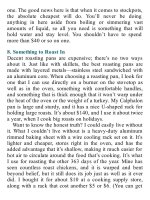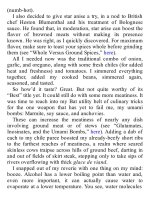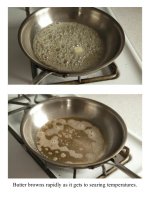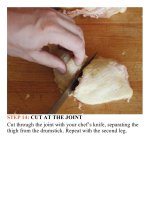The food lab better home cooking through science ( PDFDrive ) 804
Bạn đang xem bản rút gọn của tài liệu. Xem và tải ngay bản đầy đủ của tài liệu tại đây (141.35 KB, 2 trang )
principle behind, say, scratching up the surface of potatoes
before roasting them to get them extra-crisp (seehere) or
packingyourburgerextra-loosetogiveitacrisperexterior
andmorebrowning(seehere).
When roasting at 375°F, because the dehydrating and
protein setting is taking place at the same time that the
connective tissue is breaking down, there’s never really a
stagewhentheskinisrelativelysoft.Itgoesfrombeingfirm
because of the connective tissue directly to being firm
throughdehydration.
Ontheotherhand,after8hoursina250°Foven,theskin
has very little structural integrity—it’s stretchy, soft, and
easilybent.Indeed,ifyoulookedatitunderamicroscope,
you’d find that the structure of the skin very much
resembled a whole bunch of interconnected balloons just
waitingtobefilled.Howdoyoufillthoseballoons?Letheat
dotheworkforyou.
If you take that slow-cooked pork and bang it into a
preheated500°Foven,airandsteamtrappedwithintheskin
will rapidly expand, causing millions of tiny bubbles to
form.Andhere’sthekey:asthebubblesexpand,theirwalls
stretch out thinner and thinner; eventually they are so thin
thattheheatfromtheovenisabletoquiterapidlysetthem
into a permanent shape that won’t collapse even when the
porkispulledoutoftheoven.
Inthissense,pigskinisverymuchlikerawpizzadough
going into a hot oven: the high temperature causes gas
expansion, which then gets trapped in a protein matrix that
firms up in the heat of the oven to create a crunchy, crisp
crust.
Haveyoueverseenanythingsobeautiful?
I generally prefer my meat relatively unadorned—good
meat, salt, and pepper is all I need. Pork shoulder, on the
otherhand,isgreatattakingonflavor.Feelfreetorubthe
meat and skin with your favorite spice blend or dry rub
before roasting it, or—my method of choice, since it keeps
your options open—keep it plain for roasting and then
seasontheshreddedtendermeatbeforeserving.
Actually I like to bring the thing whole to the table and









